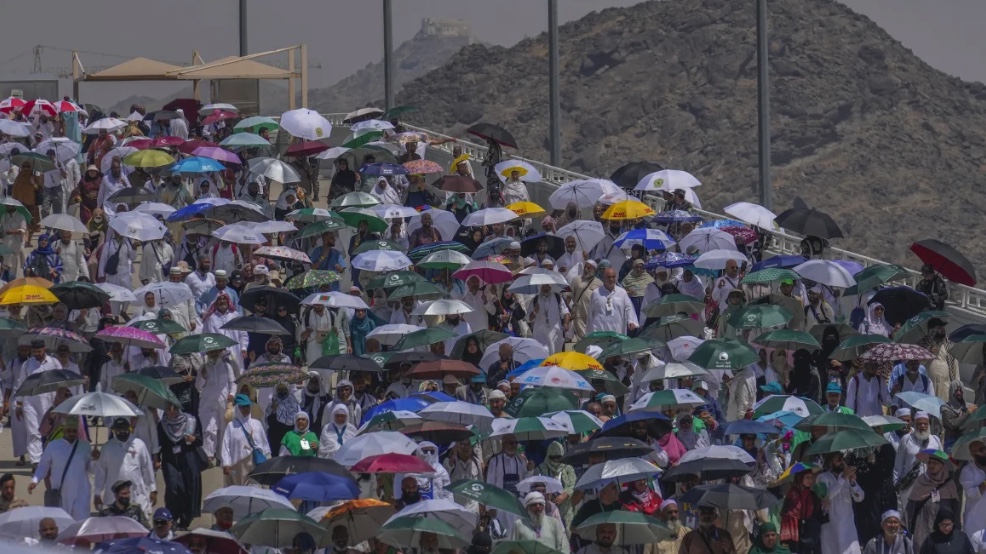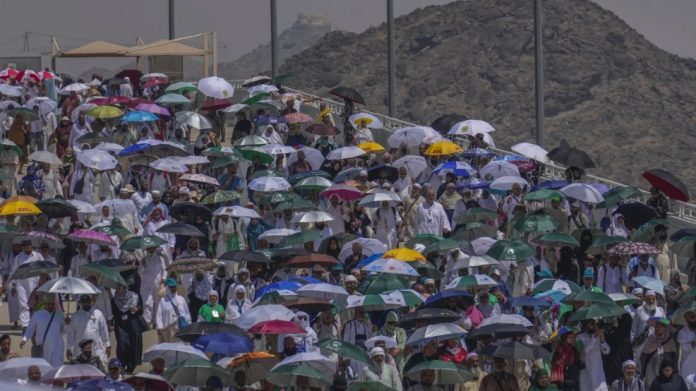มีผู้เสียชีวิตแล้วกว่า 300 ราย และอีกหลายพันคนได้รับการรักษาอาการลมแดดรหรือฮีทสโตรก ระหว่างการเดินทางไปประกอบพิธีฮัจญ์ประจำปีในเมืองเมกกะ ซึ่งอุณหภูมิพุ่งสูงถึง 49°C (120°F) เจ้าหน้าที่รายงานว่ามีชาวอินโดนีเซีย 165 คน ชาวจอร์แดน 68 คน ชาวปากีสถาน 35 คน ตูนิเซีย 35 คน และชาวอิหร่าน 11 คน อยู่ในหมู่ผู้เสียชีวิตด้วย นอกจากนี้ ชาวจอร์แดน 22 คนเข้ารับการรักษาในโรงพยาบาล และ 16 คนสูญหาย ตามที่กระทรวงการต่างประเทศจอร์แดนระบุ สภาเสี้ยววงเดือนแดงของอิหร่านรายงานว่า ชาวอิหร่านหลายสิบคนเข้ารับการรักษาในโรงพยาบาลเนื่องจากโรคลมแดดและอาการอื่นๆ คาดว่ายอดผู้เสียชีวิตจะเพิ่มขึ้นเนื่องจากซาอุดีอาระเบียและอียิปต์ยังไม่ได้เปิดเผยตัวเลขอย่างเป็นทางการ จำนวนผู้แสวงบุญที่ลงทะเบียนในปัจจุบันรวมเฉพาะผู้แสวงบุญที่ลงทะเบียนแล้ว ทำให้เกิดความกังวลเกี่ยวกับการเสียชีวิตที่ไม่ได้ลงทะเบียนเพิ่มเติม
เมื่อวันจันทร์ รัฐบาลซาอุดิอาระเบียรายงานว่าได้รักษาผู้คนกว่า 2,700 รายจากโรคลมแดด โดยหลายร้อยคนหันมาใช้โซเชียลมีเดียเพื่อค้นหาผู้เป็นที่รักที่หายไป พิธีฮัจญ์ในปีนี้ซึ่งมีผู้เข้าร่วมกว่า 1.8 ล้านคน กำลังเกิดขึ้นท่ามกลางความร้อนจัด อุณหภูมิสูงถึง 49°C (120°F) แม้ว่าจะมีผู้เสียชีวิตมากกว่า 200 รายในปีที่แล้ว แต่งานในปีนี้ก็มีความท้าทายเป็นพิเศษเนื่องจากอุณหภูมิสูงในเดือนมิถุนายน ทางการซาอุดิอาระเบียแนะนำไม่ให้ทำพิธีกรรมปาหิน (stoning of the devil)ในช่วงที่มีอากาศร้อนจัด และแนะนำให้ผู้แสวงบุญถือร่มและรักษาร่างกายให้ชุ่มชื้น กองทัพซาอุดิอาระเบียได้จัดกำลังบุคลากรทางการแพทย์มากกว่า 1,600 นาย และทีมตอบสนองอย่างรวดเร็ว 30 ทีม โดยมีอาสาสมัครสาธารณสุข 5,000 คนคอยให้ความช่วยเหลือ พิธีฮัจญ์ซึ่งเป็นเสาหลักของศาสนาอิสลาม กำหนดให้ชาวมุสลิมต้องไปเยี่ยมชมเมกกะอย่างน้อยหนึ่งครั้ง ซึ่งเกี่ยวข้องกับพิธีกรรมต่างๆ เช่น การวนรอบกะอ์บะฮ์ และการปาหินใส่สิ่งชั่วร้าย
พิธีฮัจญ์เป็นงานอันทรงเกียรติสำหรับกษัตริย์ซาอุดีอาระเบีย ผู้ดูแลมัสยิดศักดิ์สิทธิ์ทั้งสองแห่ง และเป็นแหล่งรายได้ที่สำคัญ หลังจากที่กษัตริย์ซัลมาน บิน อับดุลอาซิซขึ้นครองอำนาจในปี 2558 ซาอุดีอาระเบียได้เริ่มโครงการมูลค่า 21 พันล้านดอลลาร์เพื่อขยายมัสยิดใหญ่ในเมกกะ ในปี 2559 รองมกุฏราชกุมารโมฮัมเหม็ด บิน ซัลมาน ระบุว่าการแสวงบุญเป็นกุญแจสำคัญในการกระจายความหลากหลายของเศรษฐกิจภายในปี 2573 แม้ว่าน้ำมันจะสร้างรายได้เกือบพันล้านดอลลาร์ต่อวัน แต่ทำให้ผลกระทบทางเศรษฐกิจในปัจจุบันของการแสวงบุญค่อนข้างน้อย แต่ศักยภาพในการเติบโตในระยะยาวก็มีนัยสำคัญ รายได้จากการแสวงบุญคาดว่าจะเฉลี่ยอยู่ที่ 30 พันล้านดอลลาร์ต่อปี สร้างงาน 100,000 ตำแหน่ง รัฐบาลตั้งเป้าดึงดูดผู้แสวงบุญ 30 ล้านคนภายในปี 2573
Hundreds of Hajj pilgrims perish as temperatures in Mecca soar to 120 degrees Fahrenheit.

Over 300 people have died, and thousands have been treated for heatstroke during the annual Hajj pilgrimage in Mecca, where temperatures have soared to 49°C (120°F). Authorities report that 165 Indonesians, 68 Jordanians, 35 Pakistanis, 35 Tunisians, and 11 Iranians are among the deceased. Additionally, 22 Jordanians are hospitalised, and 16 are missing, according to the Jordanian Foreign Ministry. The Iranian Red Crescent has reported dozens of Iranians hospitalised due to heatstroke and other conditions. The death toll is expected to rise as Saudi Arabia and Egypt have yet to release official figures. The current count only includes registered pilgrims, raising concerns about additional unregistered deaths.
On Monday, the Saudi government reported treating over 2,700 people for heatstroke, with hundreds turning to social media to find missing loved ones. This year’s Hajj, with over 1.8 million participants, is occurring amid extreme heat, reaching 49°C (120°F). Despite over 200 deaths last year, this year’s event is particularly challenging due to high temperatures in June. Saudi authorities advised against performing the “stoning of the devil” ritual during peak heat hours and urged pilgrims to carry umbrellas and stay hydrated. The Saudi army deployed over 1,600 medical personnel and 30 rapid response teams, with 5,000 health volunteers assisting. Hajj, a pillar of Islam, requires Muslims to visit Mecca at least once, involving rituals such as circling the Kaaba and stoning evil.
The Hajj is a prestigious event for Saudi Arabia’s king, the Custodian of the Two Holy Mosques, and a significant revenue source. After King Salman bin Abdulaziz took power in 2015, Saudi Arabia began a $21 billion project to expand the Grand Mosque in Mecca. In 2016, then Deputy Crown Prince Mohammed bin Salman identified the pilgrimage as key to diversifying the economy by 2030. Though oil generates nearly a billion dollars a day, making the pilgrimage’s current economic impact relatively small, its potential for long-term growth is substantial. Pilgrimage revenues were projected to average $30 billion annually, creating 100,000 jobs. The government aims to attract 30 million pilgrims by 2030.
By CNN NEWS

















